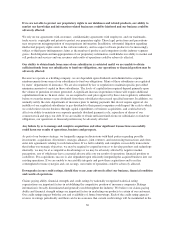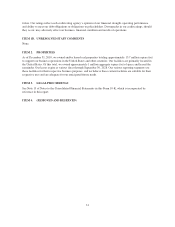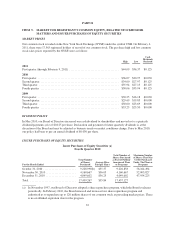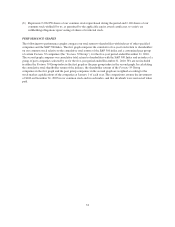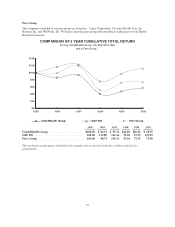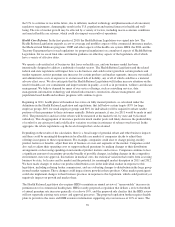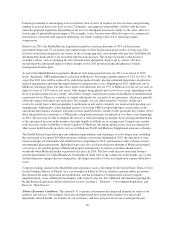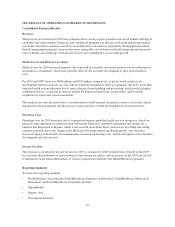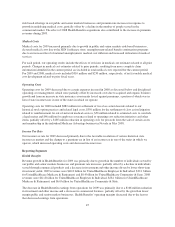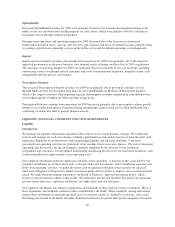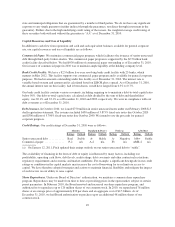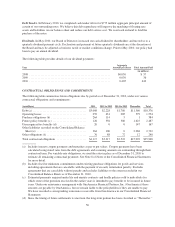United Healthcare 2010 Annual Report Download - page 42
Download and view the complete annual report
Please find page 42 of the 2010 United Healthcare annual report below. You can navigate through the pages in the report by either clicking on the pages listed below, or by using the keyword search tool below to find specific information within the annual report.Federal government is encouraging states to intensify their reviews of requests for rate increases and providing
funding to assist in those state-level reviews. Ultimately, rate approval responsibility still lies with the states
under the proposed regulation. Depending on the level of anticipated increased scrutiny by the states, there is a
broad range of potential business impacts. For example, it may become more difficult to price our commercial
risk business consistent with expected underlying cost trends, leading to the risk of operating margin
compression.
Effective in 2011, the Health Reform Legislation mandates consumer discounts of 50% on brand name
prescription drugs and 7% on generic prescription drugs for Part D plan participants in the coverage gap. This
statutory reduction in drug prices for seniors in the coverage gap may cause people who may have had difficulty
affording their medications to increase their pharmaceutical usage. The change in pricing could also have
secondary effects, such as changing the mix of brand name and generic drug usage by seniors. We have
incorporated the anticipated impact of these changes in our 2011 product pricing and pharmacy benefit
management business plan.
As part of the Health Reform Legislation, Medicare Advantage payment rates for 2011 were frozen at 2010
levels. Separately, CMS implemented a reduction in Medicare Advantage reimbursements of 1.6% for 2011. We
expect the 2011 rates will be outpaced by underlying medical trends, placing continued importance on effective
medical management and ongoing improvements in administrative costs. Beginning in 2012, additional cuts to
Medicare Advantage plans will take effect (plans will ultimately receive 95% of Medicare fee-for-service rates in
high cost areas to 115% in low cost areas), with changes being phased-in over two to six years, depending on the
level of payment reduction in a county. All of these changes could result in reduced enrollment or reimbursement
or payment levels. There are a number of annual adjustments we can make to our operations, which may partially
offset any impact from these rate reductions. For example, we can adjust members’ benefits, decide on a
county-by-county basis which geographies to participate in and seek to intensify our medical and operating cost
management. Additionally, achieving high quality scores from CMS for improving upon certain clinical and
operational performance standards will impact future quality bonuses. Quality bonus payments may further offset
these anticipated rate reductions as CMS quality rating bonus payments are phased in over three years beginning
in 2012. We also may be able to mitigate the effects of reduced funding on margins by increasing enrollment due
to the anticipated increase in the number of people eligible for Medicare in coming years. Longer term, market
wide decreases in the availability or relative quality of Medicare Advantage products may increase demand for
other senior health benefits products such as our Medicare Part D and Medicare Supplement insurance offerings.
The Health Reform Legislation presents additional opportunities and challenges over the longer term, including
the assessment of an annual $8 billion insurance industry assessment beginning in 2014, the operation of state-
based exchanges for individuals and small businesses beginning in 2014, and numerous other commercial and
governmental plan requirements. Individual states may also accelerate their procurement of Medicaid managed
care services for sizeable groups of Medicaid program beneficiaries in order to even their administrative
workloads when Medicaid market expansions take place in 2014. The law could increase near-term business
growth opportunities for UnitedHealthcare Community & State. Due to the complexity of the health care system
and the numerous changes that are taking place, the longer term effect of the new legislation remains difficult to
assess.
Court proceedings related to the Health Reform Legislation, such as the ruling by the United States District Court
for the Northern District of Florida (in a case brought on behalf of 26 state attorneys general and/or governors)
that declared the entire legislation unconstitutional, and the potential for Congressional action to impede
implementation, create additional uncertainties with respect to the law. For additional information regarding the
Health Reform Legislation and the related risk factors, see Item 1, “Business — Government Regulation” and
Item 1A, “Risk Factors.”
Adverse Economic Conditions. The current U.S. economic environment has impacted demand for some of our
products and services. For example, decreases in employment have reduced the number of workers and
dependants offered health care benefits by our customers, and have put pressure on our overall growth and
40


